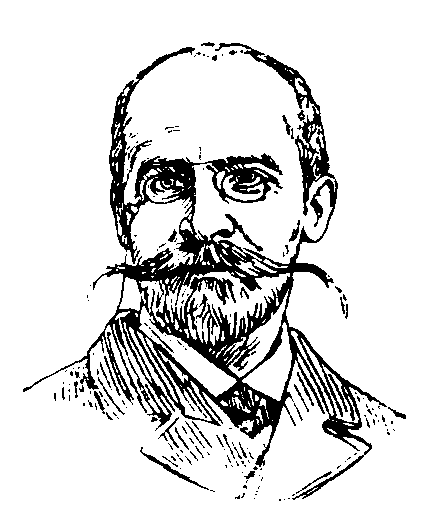This is an old revision of this page, as edited by Dr. Dan (talk | contribs) at 05:01, 24 March 2007 (Corrected typo, and added correct and factual information. Please stop vandalizing!). The present address (URL) is a permanent link to this revision, which may differ significantly from the current revision.
Revision as of 05:01, 24 March 2007 by Dr. Dan (talk | contribs) (Corrected typo, and added correct and factual information. Please stop vandalizing!)(diff) ← Previous revision | Latest revision (diff) | Newer revision → (diff)
Bruno Abdank-Abakanowicz (October 6, 1852 - August 29 1900) was a Polish mathematician, inventor and electrical engineer.
He was born in 1852 in Vilkmerge, in Lithuania, at the time a part of the Russian Empire. After graduating from the Riga Technical University (then Riga Polytechnicum), at the age of 23 Abakanowicz passed his habilitation and began an assistantship at the Technical University of Lwów. In 1881, he moved to France where he purchased a villa in Parc St. Maur on the outskirts of Paris.
There, among other things, he invented the integraph, a form of the integrator, which was patented in 1880, and was henceforth produced by the Swiss firm Coradi. Among his other patents were the parabolagraph, the spirograph, the electric bell used in trains, and an electric arc lamp of his own design. Abakanowicz published several works, including works on statistics, integrators and numerous popular scientific works, such as one describing his integraph. He was also hired by the French government as an expert on electrification and was the main engineer behind the electrification of, among other places, the city of Lyon. His patents allowed him to become a wealthy man and made him receive the Legion d'Honneur in 1889.
Around that time he retired to a small island near Trégastel, off the coast of Brittany, where between 1892 and 1896 he erected a neo-Gothic manor. Although the construction works were not finished in Abakanowicz's lifetime, the castle of Costaérès became a notable centre of Polish emigree culture, housing many notable artists, scientists and politicians. Among frequent guests of Abakanowicz were Aleksander Gierymski, Władysław Mickiewicz, Leon Wyczółkowski and Henryk Sienkiewicz. The latter became the closest friend of Abakanowicz. It was in Abakanowicz's villa in Parc St. Maur that he finished his The Teutonic Knights and The Polaniecki Family, while the Quo Vadis novel, for which Sienkiewicz was awarded with the Nobel Prize, was written entirely in Abakanowicz's manor.
Bruno Abakanowicz died suddenly on August 29, 1900. In his last will he made Sienkiewicz the tutor of his sole daughter, Zofia, who later graduated from the London School of Economics and the Sorbonne, and was murdered in the Auschwitz concentration camp during the World War II.
Nationality
He was born in the lands which were once part of the Polish-Lithuanian Commonwealth. Some documents of the time hence refer to him as a Russian. Encyclopedia Britannica mentions him as a Lithuanian mathematician in its article on the integraph. He is considered a Pole by many due to his fluent command of the language, friendship with many leading Polish personalities of the time, and literary contributions in Polish.
Bibliography
Works by Abdank-Abakanowicz
- 1886. Les intégraphes. La courbe intégrale et ses applications. Gauthier-Villars, Paris, 1886. Translated into German as Die Integraphen. Die Integralkurve und ihre Anwendungen, Teubner, Leipzig, 1889.
Notes and references
- In-line:
- Template:Pl icon Piotr Bielerzewski (2005). "Wiłkomierz". Rzeczpospolita Wirtualna. own. Retrieved 2006-09-20.
- ^ Template:Pl icon Ewa Klaputh (2006). "Le Château de Costaérès, czyli tajemnice inżyniera Abakanowicza". Po Prostu (22). Retrieved 2006-09-20.
{{cite journal}}: Cite has empty unknown parameter:|month=(help) - Template:Fr icon Bruno Abdank-Abakanowicz (1886). Les intégraphes. Paris: Gauthier-Villars.
{{cite book}}: Cite has empty unknown parameter:|chapterurl=(help) - Template:En icon
- Template:En icon sir William Henry Preece (1882). "On a New Electric Arc Lamp". Scientific American. Supplement No. 360 (1882-10-25). Retrieved 2006-09-20.
{{cite journal}}: Unknown parameter|month=ignored (help) - ^ Template:Fr icon "maison de villégiature dite Château de Costaérès". Monuments de France. 2005. Retrieved 2006-09-20.
- Template:Fr icon
- Template:Fr icon
- Template:Fr icon
See also
- For other notable members of his family see: Abakanowicz
External links
Descriptions of calculating devices developed by Abdank-Abakanowicz
- Integraph with transfer of direction by cog-wheels
- Orthogonal planimeter/integrimeter with wheel-and-cylinder mechanism, Type I
- Orthogonal planimeter/integrimeter with wheel-and-cylinder mechanism, Type II
- Continuous screw
- Logarithmic spiral
- Integraph with transfer of direction by a linkage parallelogram
- Integraph with transfer of direction by filament